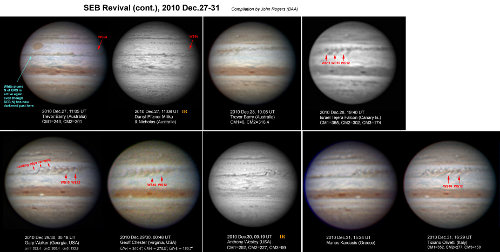
[18]
Update on SEB Revival: 2010 Dec.27-31 and 2011 Jan.1-9
The SEB Revival is continuing energetically, with all three branches now highly active in the same manner as historical examples. Attached are three more compilations of images: two covering the source and central branch, and one covering the southern branch. In the source set, red arrowheads indicate the previous 3 bright spots which appeared at or near the source: WS11, WS10, WS12. It seems that the whole of the central branch is divided into large comma-shaped cells, each of which encloses the space around one of these plumes, and includes the plume itself if still bright, dark blue-grey streaks marking the Sp. and Nf. edges, and a reddish-brown cloud on the S side.
A new white spot appeared at the source on Jan.3/4 (WS13; L2 = 294), and was methane-bright on Jan.9, though not as bright as the earlier plumes in the Revival.
The leading edge of the central branch continues to be well-defined, with occasional small bright spots appearing along it. On Jan.5, there was a dramatic change in the large, pale blue-grey wedge which had usually been present just p. this leading edge: it suddenly broke up into a series of waves spaced ~6 deg apart. This occurred within only 20 hours! Could it be due to an atmospheric wave causing simultaneous breakup of the top cloud layer over this whole region? Over the next few days, the waves became much darker and grey, and spread out in the p. direction so the spacing was ~9 deg. by Jan.9, down to the GRS. Meanwhile, also on Jan.5, dark features on the SEB(N) started to interact with the adjacent Red Spot Hollow, which is thereby darkening, and the bright plume N of the GRS is being displaced.
The third compilation of images shows the southern branch - the reviving SEB(S)-- from Dec.31 to Jan.9. JUPOS data showed a speed of +4 deg/day for the early spots in the southern branch. Various dark spots are labelled with different marks, in red or purple, in an attempt to track them visually. There seems to be no clear evidence of a latitudinal gradient of drift rate across the reviving SEB(S). Instead, some spots change their intensities quickly, making long-term tracking difficult. Nor do the dark spots have clearly organised structures. Tiny very dark spots, first clearly shown in Anthony Wesley's infrared image on Dec.31, could perhaps be little vortices, and they have apparently developed into the spots which are presently darkest. The leading edge of the southern branch is difficult to define exactly, as the leading dark projections have faded, but the darkness has become concentrated in one very large and dark spot, which should arrive at the p. edge of the Red Spot Hollow around Jan.17.
Observations of all regions are still very important, and especially of the GRS from Jan.17 onwards. Best wishes, John John H. Rogers, Ph.D. Jupiter Section Director,
British Astronomical Association